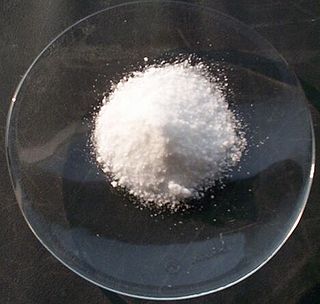
Monosodium glutamate is the sodium salt of glutamic acid, one of the most abundant naturally occurring non-essential amino acids. Glutamic acid is found naturally in tomatoes, grapes, cheese, mushrooms and other foods.
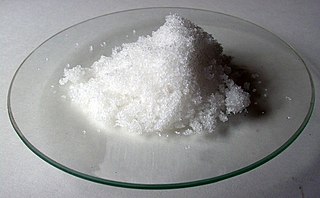
Sodium nitrate is the chemical compound with the formula NaNO3. This alkali metal nitrate salt is also known as Chile saltpeter (because large deposits of this salt can be found in Chile) to distinguish it from ordinary saltpeter, potassium nitrate. The mineral form is also known as nitratine, nitratite or soda niter.
The Reference Daily Intake (RDI) is the daily intake level of a nutrient that is considered to be sufficient to meet the requirements of 97–98% of healthy individuals in every demographic in the United States. While developed for the US population, it has been adopted by other countries, though not universally.

Acesulfame potassium, also known as acesulfame K or Ace K, is a calorie-free sugar substitute often marketed under the trade names Sunett and Sweet One. In the European Union, it is known under the E number E950. It was discovered accidentally in 1967 by German chemist Karl Clauss at Hoechst AG. In chemical structure, acesulfame potassium is the potassium salt of 6-methyl-1,2,3-oxathiazine-4(3H)-one 2,2-dioxide. It is a white crystalline powder with molecular formula C
4H
4KNO
4S and a molecular weight of 201.24 g/mol.
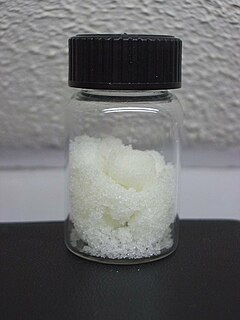
Sodium nitrite is an inorganic compound with the chemical formula NaNO2. It is a white to slightly yellowish crystalline powder that is very soluble in water and is hygroscopic. It is a useful precursor to a variety of organic compounds, such as pharmaceuticals, dyes, and pesticides, but it is probably best known as a food additive used in processed meats and (in some countries) in fish products.
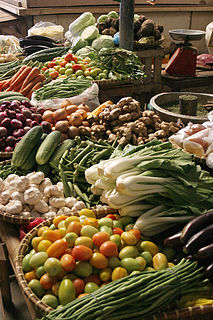
A healthy diet is a diet that helps to maintain or improve overall health. A healthy diet provides the body with essential nutrition: fluid, macronutrients, micronutrients, and adequate calories.

The origins of meat preservation are lost to the ages but probably began when humans began to realize the preservative value of salt. Sausage making originally developed as a means to preserve and transport meat. Primitive societies learned that dried berries and spices could be added to dried meat. The procedure of stuffing meat into casings remains basically the same today, but sausage recipes have been greatly refined and sausage making has become a highly respected culinary art.

Potassium sorbate is the potassium salt of sorbic acid, chemical formula CH3CH=CH−CH=CH−CO2K. It is a white salt that is very soluble in water (58.2% at 20 °C). It is primarily used as a food preservative (E number 202). Potassium sorbate is effective in a variety of applications including food, wine, and personal-care products. While sorbic acid is naturally occurring in some berries, virtually all of the world's production of sorbic acid, from which potassium sorbate is derived, is manufactured synthetically.
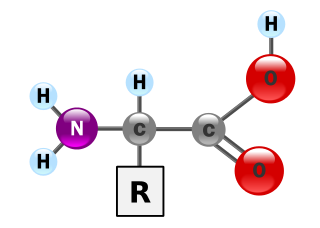
Proteins are essential nutrients for the human body. They are one of the building blocks of body tissue and can also serve as a fuel source. As a fuel, proteins provide as much energy density as carbohydrates: 4 kcal per gram; in contrast, lipids provide 9 kcal per gram. The most important aspect and defining characteristic of protein from a nutritional standpoint is its amino acid composition.

Cured fish refers to fish which has been cured by subjecting it to fermentation, pickling, smoking, or some combination of these before it is eaten. These food preservation processes can include adding salt, nitrates, nitrite or sugar, can involve smoking and flavoring the fish, and may include cooking it. The earliest form of curing fish was dehydration. Other methods, such as smoking fish or salt-curing also go back for thousands of years. The term "cure" is derived from the Latin curare, meaning to take care of. It was first recorded in reference to fish in 1743.
The Dietary Guidelines for Americans (DGA) provide nutritional advice for Americans who are more than 2 years old. The Guidelines are published every 5 years by the US Department of Agriculture, together with the US Department of Health and Human Services. The most recent edition is the 2015-2020 Dietary Guidelines for Americans. The nominal purpose of the Dietary Guidelines for Americans is to help health professionals and policymakers to advise Americans about healthy choices for their diet. Although the Dietary Guidelines for Americans are purported to be based on a systematic review of the current body of nutrition science, the Advisory Committee tasked with formulating the plan for retrieval and analysis of the scientific evidence for the current edition of the DGA used a less than rigorous process for assessing the health effects of consumption of saturated fat and salt and for assessing the health effects of a low-fat, high-carbohydrate diet. This less than rigorous review of the nutrition science literature resulted in omission of multiple large, high-quality, clinical trials and also omission of some high-quality prospective observational studies. Some Advisory Committee members also had conflicts-of-interest that in some cases were not fully disclosed. For these reasons, the quality of the Advisory Committee's Scientific Report and the validity of the 2015 - 2020 DGA itself has been challenged by critics as being unduly influenced by commercial interests and as being flawed due to confirmation bias of some members of the Advisory Committee.
A low sodium diet is a diet that includes no more than 1,500 to 2,400 mg of sodium per day.
Sodium ions (Na+) are necessary in small amounts for some types of plants, but sodium as a nutrient is more generally needed in larger amounts by animals, due to their use of it for generation of nerve impulses and for maintenance of electrolyte balance and fluid balance. In animals, sodium ions are necessary for the aforementioned functions and for heart activity and certain metabolic functions. The health effects of salt reflect what happens when the body has too much or too little sodium. Characteristic concentrations of sodium in model organisms are: 10mM in E. coli, 30mM in budding yeast, 10mM in mammalian cell and 100mM in blood plasma.
Plumping, also referred to as “enhancing” or “injecting,” is the process by which some poultry companies inject raw chicken meat with saltwater, chicken stock, seaweed extract or some combination thereof. The practice is most commonly used for fresh chicken and is also used in frozen poultry products, although other meats may also be plumped.
Canadian health claims by Health Canada, the department of the Government of Canada responsible for national health, has allowed five scientifically verified disease risk reduction claims to be used on food labels and on food advertising. Other countries, including the United States and Great Britain, have approved similar health claims on food labels.
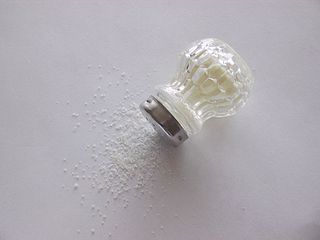
Salt consumption has been intensely studied for its role in human physiology and impact on human health. In particular, excessive dietary salt consumption over an extended period of time has been associated with hypertension and cardiovascular disease, in addition to other adverse health effects.
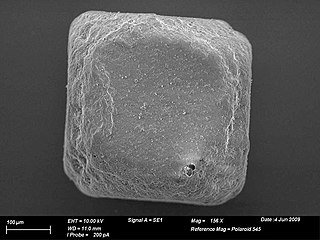
The health effects of salt are the conditions associated with the consumption of either too much or too little salt. Salt is a mineral composed primarily of sodium chloride (NaCl) and is used in food for both preservation and flavor. Sodium ions are needed in small quantities by most living things, as are chloride ions. Salt is involved in regulating the water content of the body. The sodium ion itself is used for electrical signaling in the nervous system.
Like the human practice of veganism, vegan dog foods are those formulated with the exclusion of ingredients that contain or were processed with any part of an animal, or any animal byproduct. Vegan dog food may incorporate the use of fruits, vegetables, cereals, legumes, nuts, vegetable oils, soya, as well as any other non-animal based foods. The omnivorous domestic canine has evolved to metabolize carbohydrates and thrive on a diet lower in protein, and therefore, a vegan diet may be substantial if properly formulated and balanced.

